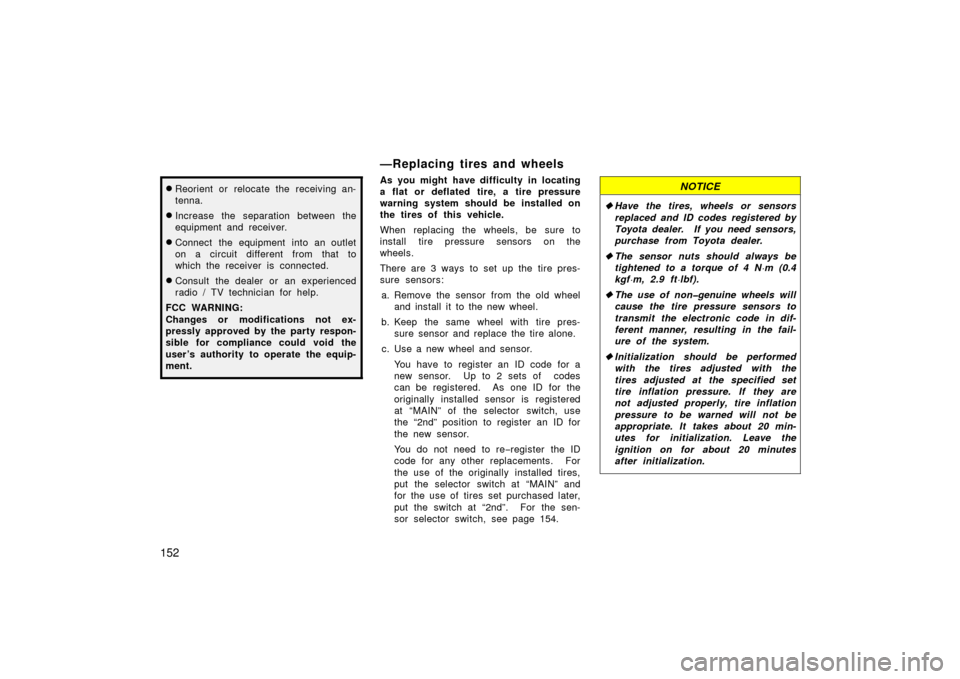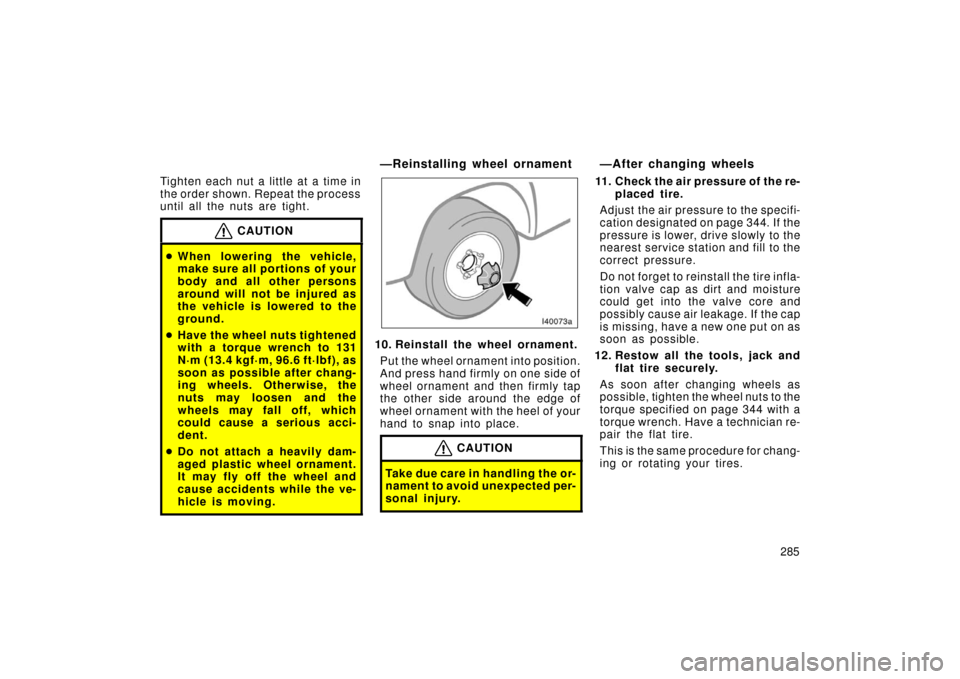Page 162 of 364

152
�Reorient or relocate the receiving an-
tenna.
�Increase the separation between the
equipment and receiver.
�Connect the equipment into an outlet
on a circuit different from that to
which the receiver is connected.
�Consult the dealer or an experienced
radio / TV technician for help.
FCC WARNING:
Changes or modifications not ex-
pressly approved by the party respon-
sible for compliance could void the
user’s authority to operate the equip-
ment.
—Replacing tires and wheels
As you might have difficulty in locating
a flat or deflated tire, a tire pressure
warning system should be installed on
the tires of this vehicle.
When replacing the wheels, be sure to
install tire pressure sensors on the
wheels.
There are 3 ways to set up the tire pres-
sure sensors: a. Remove the sensor from the old wheel and install it to the new wheel.
b. Keep the same wheel with tire pres- sure sensor and replace the tire alone.
c. Use a new wheel and sensor.
You have to register an ID code for a
new sensor. Up to 2 sets of codes
can be registered. As one ID for the
originally installed sensor is registered
at “MAIN” of the selector switch, use
the “2nd” position to register an ID for
the new sensor.
You do not need to re −register the ID
code for any other replacements. For
the use of the originally installed tires,
put the selector switch at “MAIN” and
for the use of tires set purchased later,
put the switch at “2nd”. For the sen-
sor selector switch, see page 154.NOTICE
� Have the tires, wheels or sensors
replaced and ID codes registered by
Toyota dealer. If you need sensors,
purchase from Toyota dealer.
� The sensor nuts should always be
tightened to a torque of 4 N·m (0.4
kgf·m, 2.9 ft·lbf).
� The use of non�genuine wheels will
cause the tire pressure sensors to
transmit the electronic code in dif-
ferent manner, resulting in the fail-
ure of the system.
� Initialization should be performed
with the tires adjusted with the
tires adjusted at the specified set
tire inflation pressure. If they are
not adjusted properly, tire inflation
pressure to be warned will not be
appropriate. It takes about 20 min-
utes for initialization. Leave the
ignition on for about 20 minutes
after initialization.
Page 295 of 364

285
Tighten each nut a little at a time in
the order shown. Repeat the process
until all the nuts are tight.
CAUTION
�
When lowering the vehicle,
make sure all portions of your
body and all other persons
around will not be injured as
the vehicle is lowered to the
ground.
� Have the wheel nuts tightened
with a torque wrench to 131
N·m (13.4 kgf·m, 96.6 ft·lbf), as
soon as possible after chang-
ing wheels. Otherwise, the
nuts may loosen and the
wheels may fall off, which
could cause a serious acci-
dent.
� Do not attach a heavily dam-
aged plastic wheel ornament.
It may fly off the wheel and
cause accidents while the ve-
hicle is moving.
—Reinstalling wheel ornament
10. Reinstall the wheel ornament.
Put the wheel ornament into position.
And press hand firmly on one side of
wheel ornament and then firmly tap
the other side around the edge of
wheel ornament with the heel of your
hand to snap into place.
CAUTION
Take due care in handling the or-
nament to avoid unexpected per-
sonal injury.
—After changing wheels
11. Check the air pressure of the re- placed tire.
Adjust the air pressu re to the specifi-
cation designated on page 344. If the
pressure is lower, dr ive slowly to the
nearest service station and fill to the
correct pressure.
Do not forget to reinstall the tire infla-
tion valve cap as dirt and moisture
could get into th e valve core and
possibly cause air leakage. If the cap
is missing, have a new one put on as
soon as possible.
12. Restow all the tools, jack and flat tire securely.
As soon after changing wheels as
possible, tighten the wheel nuts to the
torque specified on page 344 with a
torque wrench. Have a technician re-
pair the flat tire.
This is the same procedure for chang-
ing or rotating your tires.
Page 354 of 364
344
Tires
Tire size and inflation pressure:kPa (psi)
Ti r e siz e
FrontRearWheel sizeNormal drivingTr ailer towingNormal drivingTr ailer towing
P275/60R18 111H200 (29)220 (32)220 (32)240 (35)18 � 8JJ
Wheel nut torque, N·m (kgf·m, ft·lbf): 131 (13.4, 96.6)
NOTE: For a complete information on tires (e.g. replacing tires or replacing wheels), see “Checking tire inflation pressure” on page 320 through “Aluminum wheel precautions” on page 328.